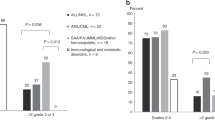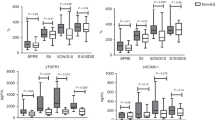Abstract
In this review, we analyse the role of the endothelium in the development of several complications that appear soon after haematopoietic SCT (HSCT). Once it had been demonstrated that sinusoidal damage is the initiating event of the sinusoidal obstruction syndrome, it was considered that other short-term complications with overlapping clinical manifestations, such as capillary leak syndrome, engraftment syndrome, transplant-associated microangiopathy, diffuse alveolar haemorrhage and idiopathic pneumonia syndrome, could have an endothelial origin. During HSCT, endothelial cells (ECs) are activated and damaged by several factors, including conditioning, cytokines released by damaged tissues, endotoxins translocated through damaged mucosa, drugs used in the procedure, the engraftment, and—in the allogeneic setting—immunological reactions. The different clinical syndromes that occur could be determined by the predominant phenotypic change in the ECs and the location of this change (organ dependant or systemic). Several translational studies have provided evidence of this endothelial dysfunction on the basis of analysis of soluble markers, soluble forms of adhesion molecules, the enumeration of circulating ECs and microparticles, and morphologic and functional changes induced in cultured ECs. This increased knowledge has opened up a wide range of potential pharmacologic interventions to prevent or treat endothelial damage and, consequently, to improve the outcome of patients receiving HSCT.
This is a preview of subscription content, access via your institution
Access options
Subscribe to this journal
Receive 12 print issues and online access
$259.00 per year
only $21.58 per issue
Buy this article
- Purchase on Springer Link
- Instant access to full article PDF
Prices may be subject to local taxes which are calculated during checkout




Similar content being viewed by others
References
Ljungman P, Bregni M, Brune M, Cornelissen J, de Witte T, Dini G et al. Allogeneic and autologous transplantation for haematological diseases, solid tumours and immune disorders: current practice in Europe 2009. Bone Marrow Transplant 2010; 45: 219–234.
McDonald GB, Hinds MS, Fisher LD, Schoch HG, Wolford JL, Banaji M et al. Veno-occlusive disease of the liver and multiorgan failure after bone marrow transplantation: a cohort study of 355 patients. Ann Intern Med 1993; 118: 255–267.
Jones RJ, Lee KS, Beschorner WE, Vogel VG, Grochow LB, Braine HG et al. Venoocclusive disease of the liver following bone marrow transplantation. Transplantation 1987; 44: 778–783.
Carreras E, Bertz H, Arcese W, Vernant JP, Tomás JF, Hagglund H et al. Incidence and outcome of hepatic veno-occlusive disease after blood or marrow transplantation: a prospective cohort study of the European Group for Blood and Marrow Transplantation. Blood 1998; 92: 3599–3604.
DeLeve LD, Shulman HM, McDonald GB . Toxic injury to hepatic sinusoids: sinusoidal obstruction syndrome (veno-occlusive disease). Semin Liver Dis 2002; 22: 27–42. (review).
Kumar S, DeLeve LD, Kamath PS, Tefferi A . Hepatic veno-occlusive disease (sinusoidal obstruction syndrome) after hematopoietic stem cell transplantation. Mayo Clin Proc 2003; 78: 589–598.
DeLeve LD, Wang X, McCuskey MK, McCuskey RS . Rat liver endothelial cells isolated by anti-CD31 immunomagnetic separation lack fenestrae and sieve plates. Am J Physiol Gastrointest Liver Physiol 2006; 291: G1187–G1189.
Aird WC . Endothelium in health and disease. Pharmacol Rep 2008; 60: 139–143.
Eissner G, Multhoff G, Holler E . Influence of bacterial endotoxin on the allogenicity of human endothelial cells. Bone Marrow Transplant 1998; 21: 1286–1288.
Fusté B, Mazzara R, Escolar G, Merino A, Ordinas A, Díaz-Ricart M . Granulocyte colony-stimulating factor increases expression of adhesion receptors on endothelial cells through activation of p38 MAPK. Haematologica 2004; 89: 578–585.
Mercanoglu F, Turkmen A, Kocaman O, Pinarbasi B, Dursun M, Selcukbiricik F et al. Endothelial dysfunction in renal transplant patients is closely related to serum cyclosporine levels. Transplant Proc 2004; 36: 1357–1360.
Biedermann BC . Vascular endothelium: checkpoint for inflammation and immunity. News Physiol Sci 2001; 16: 84–88.
Cooke KR, Jannin A, Ho V . The contribution of endothelial activation and injury to end-organ toxicity following allogeneic hematopoietic stem cell transplantation. Biol Blood Marrow Transplant 2008; 14: 23–32.
Carreras E . Early complications after HSCT. In: Apperley J, Carreras E, Gluckman E, Gratwohl A, Mazzi T (eds). Haematopoietic Stem Cell Transplantation. Forum Service Editore: Genova, 2008, pp 180–195.
Palomo M, Diaz-Ricart M, Carbo C, Rovira M, Fernandez-Aviles F, Martine C et al. Endothelial dysfunction after hematopoietic stem cell transplantation: role of the conditioning regimen and the type of transplantation. Biol Blood Marrow Transplant 2010; 16: 985–993.
Biedermann BC . Vascular endothelium and graft-versus-host disease. Best Pract Res Clin Haematol 2008; 21: 129–138.
Tichelli A, Passweg J, Wójcik D, Rovó A, Harousseau JL, Masszi T et al. Late cardiovascular events after allogeneic hematopoietic stem cell transplantation: a retrospective multicenter study of the late effects working party of the european group for blood and marrow transplantation. Haematologica 2008; 93: 1203–1210.
Richard S, Seigneur M, Blann A, Adams R, Renard M, Puntous M et al. Vascular endothelial lesion in patients undergoing bone marrow transplantation. Bone Marrow Transplant 1996; 18: 955–959.
Catani L, Gugliotta L, Vianelli N, Nocentini F, Baravelli S, Bandini G et al. Endothelium and bone marrow transplantation. Bone Marrow Transplant 1996; 17: 277–280.
Zeigler ZR, Rosenfeld CS, Andrews DF, Nemunaitis J, Raymond JM, Shadduck RK et al. Plasma von Willebrand factor antigen (vWF:AG) and thrombomodulin (TM) levels in adult thrombotic thrombocytopenic purpura/hemolytic uremic syndromes (TTP/HUS) and bone marrow transplant-associated thrombotic microangiopathy (BMT-TM). Am J Hematol 1996; 53: 213–220.
Salat C, Holler E, Kolb HJ, Pihusch R, Reinhardt B, Hiller E . Endothelial cell markers in bone marrow transplant recipients with and without acute graft-versus-host disease. Bone Marrow Transplant 1997; 19: 909–914.
Nurnberger W, Michelmann I, Burdach S, Gobel U . Endothelial dysfunction after bone marrow transplantation: increase of soluble thrombomodulin and PAI-1 in patients with multiple transplant-related complications. Ann Hematol 1998; 76: 61–65.
Takatsuka H, Wakae T, Mori A, Okada M, Okamoto T, Kakishita E . Effects of total body irradiation on the vascular endothelium. Clin Transplant 2002; 16: 374–377.
Matsuda Y, Hara J, Osugi Y, Tokimasa S, Fujisaki H, Takai K et al. Serum levels of soluble adhesion molecules in stem cell transplantation-related complications. Bone Marrow Transplant 2001; 27: 977–982.
Park YD, Yoshioka A, Kawa K, Ishizashi H, Yagi H, Yamamoto Y et al. Impaired activity of plasma von Willebrand factor-cleaving protease may predict the occurrence of hepatic veno-occlusive disease after stem cell transplantation. Bone Marrow Transplant 2002; 29: 789–794.
Luzzatto G, Cella G, Messina C, Randi ML, Sbarai A, Zanesco L . Markers of endothelial function in pediatric stem cell transplantation for acute leukemia. Med Pediatr Oncol 2003; 40: 9–12.
Rio B, Petropoulou AD, Mirshahi P, Soria J, Rendu F, Samama MM et al. Endothelial cell markers’ kinetics following umbilical cord blood transplantation. Leuk Lymphoma 2008; 49: 2209–2212.
Cutler C, Kim HT, Ayanian S, Bradwin G, Revta C, Aldridge J et al. Prediction of veno-occlusive disease using biomarkers of endothelial injury. Biol Blood Marrow Transplant 2010; 16: 1180–1185.
Palomo M, Diaz-Ricart M, Carbo C, Rovira M, Fernandez-Aviles F, Escolar G et al. The release of soluble factors contributing to endothelial activation and damage after hematopoietic stem cell transplantation is not limited to the allogeneic setting and involves several pathogenic mechanisms. Biol Blood Marrow Transplant 2009; 15: 537–546.
Palomo M, Diaz-Ricart M, Rovira M, Escolar G, Carreras E . Defibrotide prevents the activation of macrovascular and microvascular endothelia caused by autologous hematopoietic stem cell transplantation. Biol Blood Marrow Transplant 2011; 17: 497–506.
Ogura H, Tanaka H, Koh T, Fujita K, Fujimi S, Nakamori Y et al. Enhanced production of endothelial microparticles with increased binding to leukocytes in patients with severe systemic inflammatory response syndrome. J Trauma 2004; 56: 823–830.
Blann AD, Woywodt A, Bertolini F, Bull TM, Buyon JP, Clancy RM et al. Circulating endothelial cells. Biomarker of vascular disease. Thromb Haemost 2005; 93: 228–235.
Pihusch V, Rank A, Steber R, Pihusch M, Pihusch R, Toth B et al. Endothelial cell-derived microparticles in allogeneic hematopoietic stem cell recipients. Transplantation 2006; 81: 1405–1409.
Woywodt A, Haubitz M, Buchholz S, Hertenstein B . Counting the cost: markers of endothelial damage in hematopoietic stem cell transplantation. Bone Marrow Transplant 2004; 34: 1015–1023.
Woywodt A, Scheer J, Hambach L, Buchholz S, Ganser A, Haller H et al. Circulating endothelial cells as a marker of endothelial damage in allogeneic hematopoietic stem cell transplantation. Blood 2004; 103: 3603–3605.
Eissner G, Kohlhuber F, Grell M, Buchholz S, Ganser A, Haller H et al. Critical involvement of transmembrane tumor necrosis factor-alpha in endothelial programmed cell death mediated by ionizing radiation and bacterial endotoxin. Blood 1995; 86: 4184–4193.
Eissner G, Multhoff G, Gerbitz A, Kirchner S, Bauer S, Haffner S et al. Fludarabine induces apoptosis, activation, and allogenicity in human endothelial and epithelial cells: protective effect of defibrotide. Blood 2002; 100: 334–340.
Ganster A, Brucker I, Holler E, Hahn J, Bremm H, Andreesen R et al. In vitro monitoring of endothelial complications following hematopoietic allogeneic stem cell transplantation. Bone Marrow Transplant 2004; 33: 355–357.
Carreras E . Veno-occlusive disease of the liver after hemopoietic cell transplanttation. Eur J Haematol 2000; 64: 281–291.
Richardson PG, Elias AD, Krishnan A, Wheeler C, Nath R, Hoppensteadt D et al. Treatment of severe veno-occlusive disease with defibrotide: compassionate use results in response without significant toxicity in a high-risk population. Blood 1998; 92: 737–744.
Richardson PG, Murakami C, Jin Z, Warren D, Momtaz P, Hoppensteadt D et al. Multi-institutional use of defibrotide in 88 patients after stem cell transplantation with severe veno-occlusive disease and multisystem organ failure: response without significant toxicity in a high-risk population and factors predictive of outcome. Blood 2002; 100: 4337–4343.
Richardson PG, Soiffer RJ, Antin JH, Uno H, Jin Z, Kurtzberg J et al. Defibrotide for the treatment of severe hepatic veno-occlusive disease and multiorgan failure after stem cell transplantation: a multicenter, randomized, dose-finding trial. Biol Blood Marrow Transplant 2010; 16: 1005–1017.
Corbacioglu S, Cesaro S, Faraci M, Valteau-Couanet D, Gruhn B, Boelens JJ et al. Defibrotide prevents hepatic VOD and reduces significantly VOD-associated complications in children at high risk: final results of a prospective phase II/III muticentre study. Bone Marrow Transplant 2010; 45 (Suppl 2): S1.
Beşişik SK, Oztürk GB, Calişkan Y, Sargin D . Complete resolution of transplantation-associated thrombotic microangiopathy and hepatic veno-occlusive disease by defibrotide and plasma exchange. Turk J Gastroenterol 2005; 16: 34–37.
Pescador R, Porta R, Ferro L . An integrated view of the activities of defibrotide. Semin Thromb Hemost 1996; 22 (Suppl 1): 71–75.
Eissner G, Iacobelli M, Blüml S, Burger V, Haffner S, Andreesen R et al. Oligotide, a defibrotide derivative, protects human microvascular endothelial cells against fludarabine-induced activation, damage and allogenicity. Bone Marrow Transplant 2005; 35: 915–920.
Acknowledgements
This work has been partially supported by grants: FIS PI081056 (Fondo de Investigaciones de la Seguridad Social), German José Carreras Leukaemia Foundation (R 07/41v), SAF 2009-10365 (Ministerio de Ciencia y Tecnología), RD06/0009/1003 (Red HERACLES, Instituto de Salud Carlos III).
We thank Jordi Bozzo for providing the images included in Figures 1 and 3.
Author information
Authors and Affiliations
Corresponding author
Ethics declarations
Competing interests
The authors declare no conflict of interest.
Rights and permissions
About this article
Cite this article
Carreras, E., Diaz-Ricart, M. The role of the endothelium in the short-term complications of hematopoietic SCT. Bone Marrow Transplant 46, 1495–1502 (2011). https://doi.org/10.1038/bmt.2011.65
Received:
Accepted:
Published:
Issue Date:
DOI: https://doi.org/10.1038/bmt.2011.65
Keywords
This article is cited by
-
Low incidence of engraftment syndrome following allogeneic hematopoietic cell transplantation with post-transplant cyclophosphamide
Bone Marrow Transplantation (2024)
-
Liver stiffness measurements predict Sinusoidal Obstructive Syndrome after hematopoietic stem cell transplantation
Bone Marrow Transplantation (2024)
-
Complement inhibitors in pediatric kidney diseases: new therapeutic opportunities
Pediatric Nephrology (2024)
-
Analysis of laboratory parameters before the occurrence of hepatic sinusoidal obstruction syndrome in children, adolescents, and young adults after hematopoietic stem cell transplantation
Journal of Cancer Research and Clinical Oncology (2024)
-
Potential factors for and the prognostic impact of ascites after allogeneic hematopoietic stem cell transplantation
Scientific Reports (2023)



